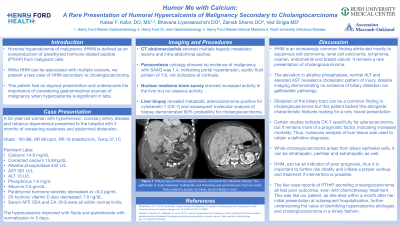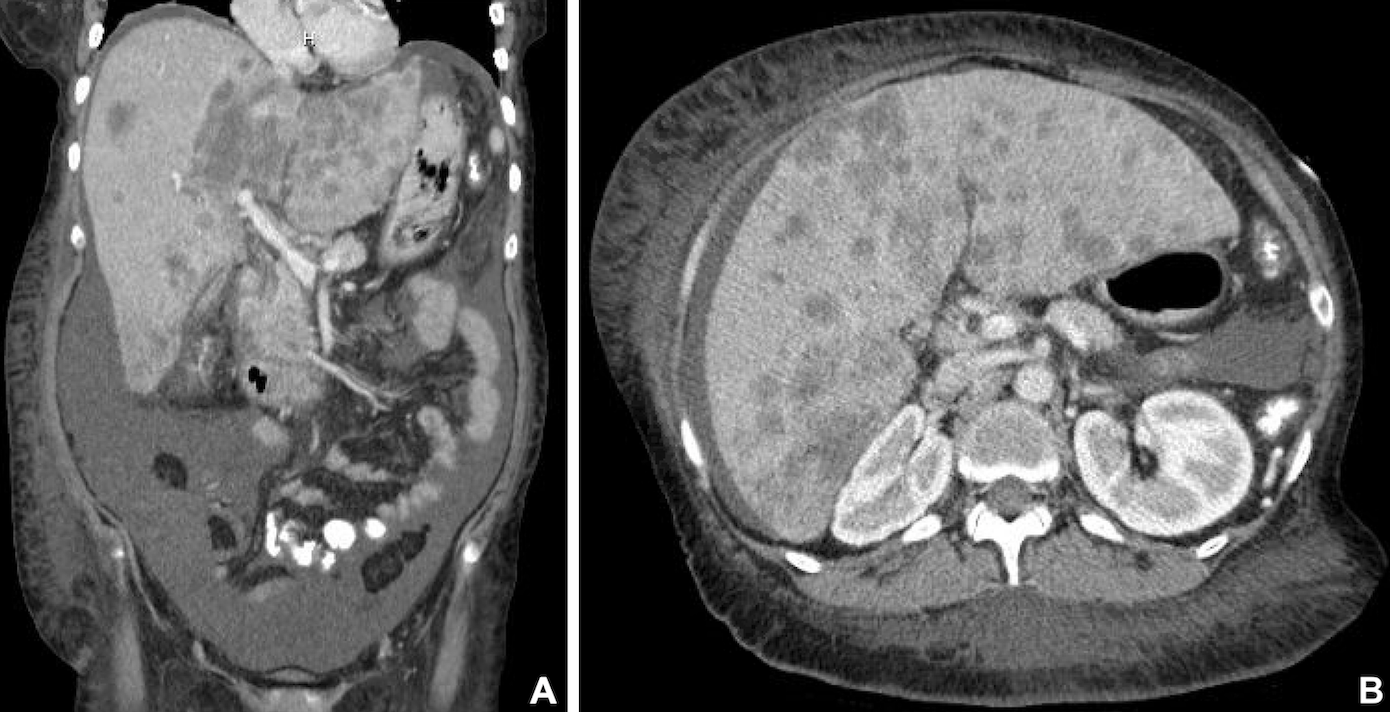Tuesday Poster Session
Category: Biliary/Pancreas
P3578 - Humor Me With Calcium: A Rare Presentation of Humoral Hypercalcemia of Malignancy Secondary to Cholangiocarcinoma
Tuesday, October 29, 2024
10:30 AM - 4:00 PM ET
Location: Exhibit Hall E

Has Audio
- KK
Kaiser Kabir, DO, MS
Ascension Macomb-Oakland Hospital
Ferndale, MI
Presenting Author(s)
Kaiser Kabir, DO, MS1, Bhavana Liyanaarachchi, DO2, Zainab Shams, DO3, Ved Singla, MD2
1Ascension Macomb-Oakland Hospital, Detroit, MI; 2Ascension Macomb-Oakland Hospital, Warren, MI; 3Rush University Medical Center, Chicago, IL
Introduction: Humoral hypercalcemia of malignancy (HHM) is defined as an overproduction of parathyroid hormone-related peptide (PTHrP) from malignant cells. While HHM can be associated with multiple cancers, we present a case secondary to an atypical presentation of cholangiocarcinoma. HHM can be an indicator of poor prognosis, thus it is important to begin appropriate workup and treatment, especially if intervention is possible.
Case Description/Methods: A 55-year-old woman with a history of coronary artery disease and tobacco use presented to the hospital with worsening weakness and abdominal expansion of 2 months. Labs were notable for a corrected calcium of 15.8mg/dL, alkaline phosphatase of 442 U/L, AST 301 U/L, ALT 13 U/L, phosphorus 1.6mg/dL, parathyroid hormone of less than 6.0pg/mL and 25-hydroxyvitamin D of 7.0ng/dL. The hypercalcemia improved with fluids and pamidronate. CT abdomen/pelvis showed multiple hepatic metastases and ascites. Paracentesis cytology showed no evidence of malignancy. Serum alpha-fetoprotein, CEA and CA 19-9 were normal. A nuclear medicine bone survey showed increased activity in the liver but no osseous activity. A liver biopsy revealed metastatic adenocarcinoma positive for cytokeratin 7 (CK7) and molecular analysis demonstrated a 90% probability for cholangiocarcinoma. Unfortunately, within a month of diagnosis, the patient passed in a subsequent hospitalization.
Discussion: HHM is an increasingly common finding attributed to breast cancer, renal cell carcinoma, lymphoma, ovarian and endometrial cancer. It is a rare presentation of cholangiocarcinoma. This patient’s hypercalcemia with low phosphorus, parathyroid and vitamin D levels warranted investigation for malignancy. Dilatation of the biliary tract can be a common finding in cholangiocarcinoma. Though this patient's elevation in alkaline phosphatase and AST with normal ALT indicated a cholestatic pattern of injury, imaging revealed no biliary ductal dilatation. While cholangiocarcinoma arises from biliary epithelial cells, it can be intrahepatic, perihilar and extrahepatic. Studies indicate CK7 specificity for adenocarcinoma, but it remains more of a prognostic factor. Surgical resection may be curative for cholangiocarcinoma but unlikely in metastatic disease. The few case reports of PTHrP-secreting cholangiocarcinoma all had poor outcomes, despite chemotherapy, further underscoring the value of identifying hypercalcemia etiology and gastrointestinal malignancy.

Disclosures:
Kaiser Kabir, DO, MS1, Bhavana Liyanaarachchi, DO2, Zainab Shams, DO3, Ved Singla, MD2. P3578 - Humor Me With Calcium: A Rare Presentation of Humoral Hypercalcemia of Malignancy Secondary to Cholangiocarcinoma, ACG 2024 Annual Scientific Meeting Abstracts. Philadelphia, PA: American College of Gastroenterology.
1Ascension Macomb-Oakland Hospital, Detroit, MI; 2Ascension Macomb-Oakland Hospital, Warren, MI; 3Rush University Medical Center, Chicago, IL
Introduction: Humoral hypercalcemia of malignancy (HHM) is defined as an overproduction of parathyroid hormone-related peptide (PTHrP) from malignant cells. While HHM can be associated with multiple cancers, we present a case secondary to an atypical presentation of cholangiocarcinoma. HHM can be an indicator of poor prognosis, thus it is important to begin appropriate workup and treatment, especially if intervention is possible.
Case Description/Methods: A 55-year-old woman with a history of coronary artery disease and tobacco use presented to the hospital with worsening weakness and abdominal expansion of 2 months. Labs were notable for a corrected calcium of 15.8mg/dL, alkaline phosphatase of 442 U/L, AST 301 U/L, ALT 13 U/L, phosphorus 1.6mg/dL, parathyroid hormone of less than 6.0pg/mL and 25-hydroxyvitamin D of 7.0ng/dL. The hypercalcemia improved with fluids and pamidronate. CT abdomen/pelvis showed multiple hepatic metastases and ascites. Paracentesis cytology showed no evidence of malignancy. Serum alpha-fetoprotein, CEA and CA 19-9 were normal. A nuclear medicine bone survey showed increased activity in the liver but no osseous activity. A liver biopsy revealed metastatic adenocarcinoma positive for cytokeratin 7 (CK7) and molecular analysis demonstrated a 90% probability for cholangiocarcinoma. Unfortunately, within a month of diagnosis, the patient passed in a subsequent hospitalization.
Discussion: HHM is an increasingly common finding attributed to breast cancer, renal cell carcinoma, lymphoma, ovarian and endometrial cancer. It is a rare presentation of cholangiocarcinoma. This patient’s hypercalcemia with low phosphorus, parathyroid and vitamin D levels warranted investigation for malignancy. Dilatation of the biliary tract can be a common finding in cholangiocarcinoma. Though this patient's elevation in alkaline phosphatase and AST with normal ALT indicated a cholestatic pattern of injury, imaging revealed no biliary ductal dilatation. While cholangiocarcinoma arises from biliary epithelial cells, it can be intrahepatic, perihilar and extrahepatic. Studies indicate CK7 specificity for adenocarcinoma, but it remains more of a prognostic factor. Surgical resection may be curative for cholangiocarcinoma but unlikely in metastatic disease. The few case reports of PTHrP-secreting cholangiocarcinoma all had poor outcomes, despite chemotherapy, further underscoring the value of identifying hypercalcemia etiology and gastrointestinal malignancy.

Figure: A and B. CT Abdomen/Pelvis demonstrates multiple hypoenhancing hepatic metastatic lesions. The gallbladder is under-distended with some wall thickening. There is also pericholecystic fluid noted, likely related to ascites. There is no visible evidence of biliary ductal dilatation in either view.
Disclosures:
Kaiser Kabir indicated no relevant financial relationships.
Bhavana Liyanaarachchi indicated no relevant financial relationships.
Zainab Shams indicated no relevant financial relationships.
Ved Singla indicated no relevant financial relationships.
Kaiser Kabir, DO, MS1, Bhavana Liyanaarachchi, DO2, Zainab Shams, DO3, Ved Singla, MD2. P3578 - Humor Me With Calcium: A Rare Presentation of Humoral Hypercalcemia of Malignancy Secondary to Cholangiocarcinoma, ACG 2024 Annual Scientific Meeting Abstracts. Philadelphia, PA: American College of Gastroenterology.
